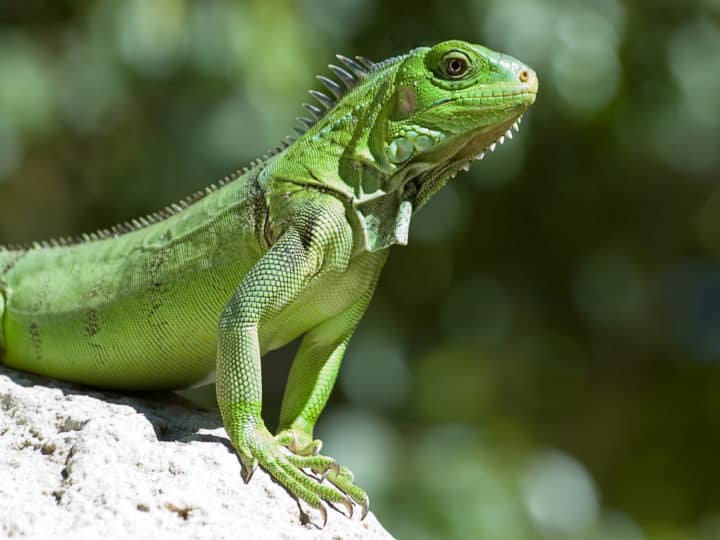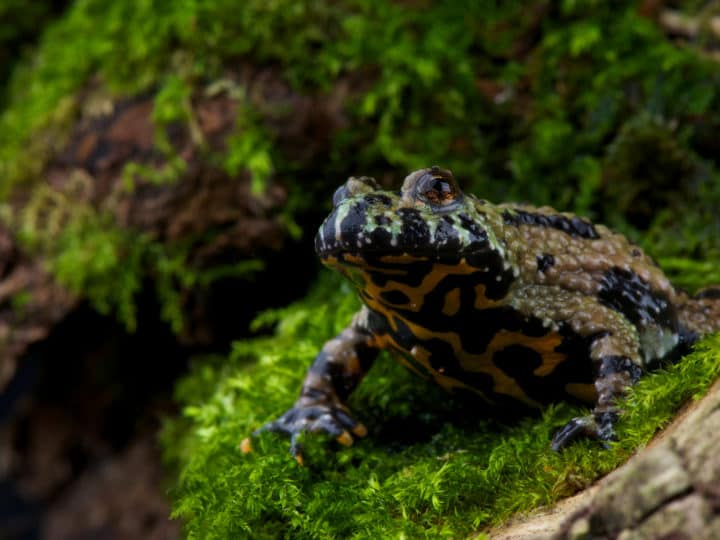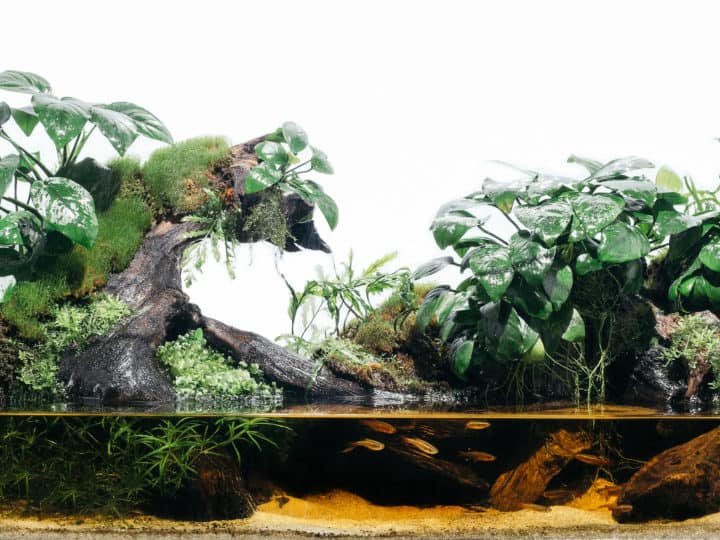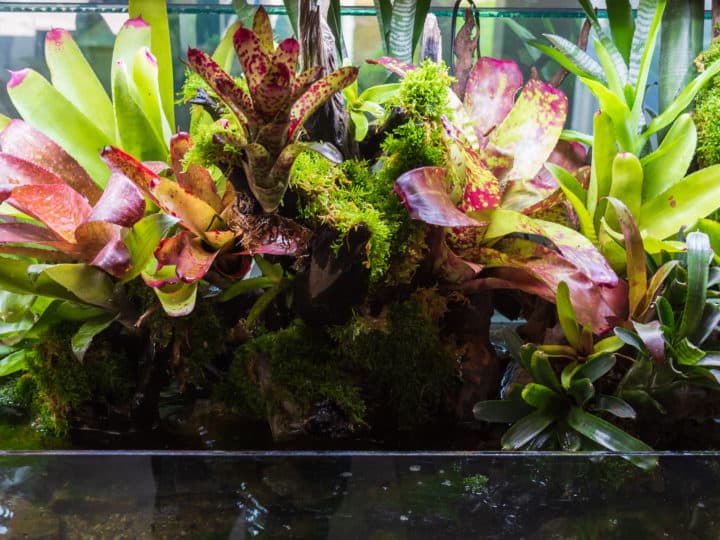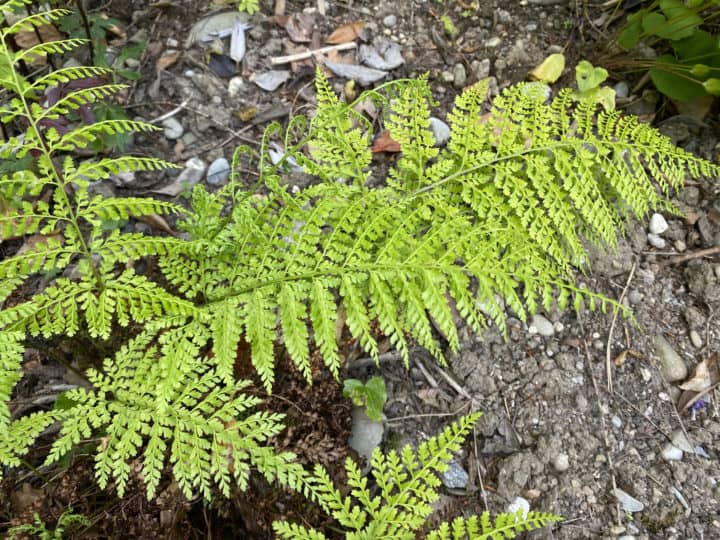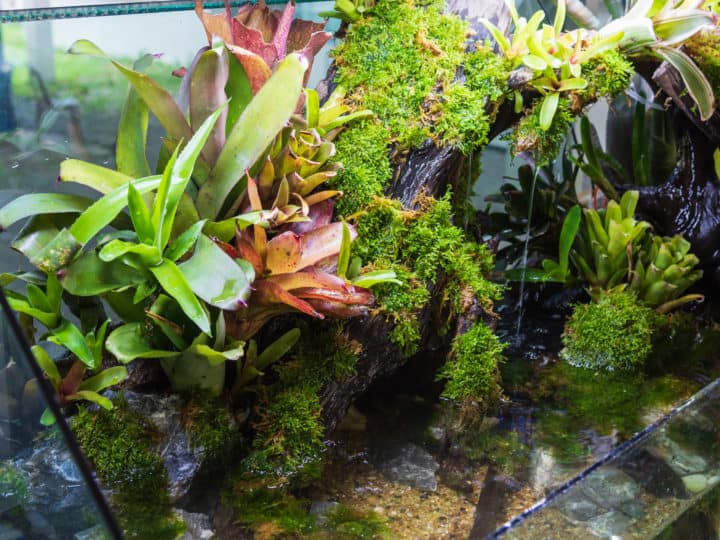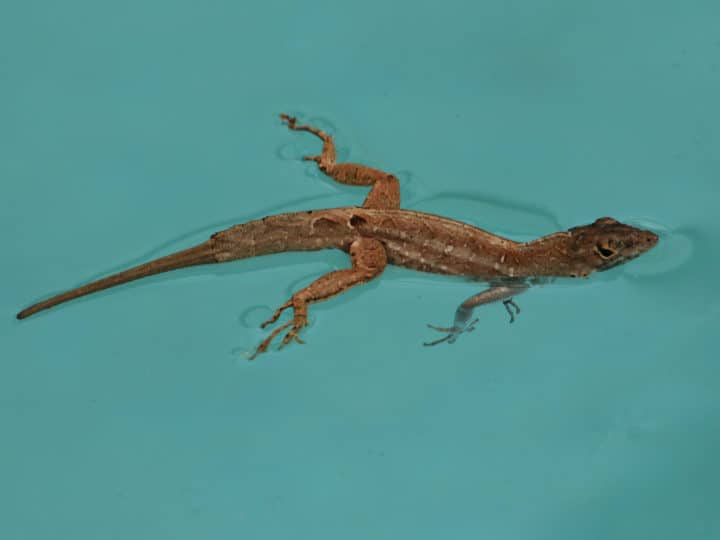When starting your paludarium, it can be challenging to decide which lizards you’re going to put inside it. After all, some lizards are best in bare-bones enclosures, while others will be almost impossible to see once you get everything set up. It’s important to pick the right animal to ensure you have the best paludarium possible.
Here are the 5 best lizards to keep in a paludarium:
- Jackson Chameleon
- Crested Geckos
- Green Anoles
- Giant Day Gecko
- Caiman Lizard
Now I’ll go more in-depth about each of these species so you can make an informed decision regarding which one you’ll add to your paludarium. Each will be a perfect addition to someone’s paludarium and has many pros and cons.
1. Jackson Chameleon
If you’re looking for one lizard that can be the king, or queen, of your paludarium, a Jackson Chameleon is a great option. While they’re solitary and often become aggressive to other members of their own species, they’re a great option for your paludarium for a couple of reasons.
For one, they’re typically non-destructive, unlike many other lizards. Lizards such as the bearded dragon would quickly tear apart an intricate paludarium, and you’d spend most of your time trying to reassemble all the features. A Jackson Chameleon will simply spend its days slowly crawling around the enclosure.
While they eat insects and are technically predators, they won’t spend their time hunting down the other inhabitants of your paludarium as long as you keep them well-fed. The lizard’s predatory instincts are one of the most important things you’ll need to consider when selecting your centerpiece animal. If you pick a lizard that’s too predatory, you could end up losing the rest of the animals you put in the paludarium.
Keep in mind that the Jackson Chameleon can’t swim. If your paludarium includes deep water features—and by deep, I mean more than a couple of centimeters—you’ll need to place nets over the water so your chameleon doesn’t accidentally fall in.
While chameleons are not prone to falls—after all, they’ve evolved to live in the trees—it can still happen. And if they fall into the water, the results can be devastating.
2. Crested Geckos
Another excellent option for your paludarium is a small group of Crested Geckos. These are some of the most popular options for paludariums, and for a good reason. After all, they’re small, undestructive, generally non-aggressive toward one another, and non-predatory, so they won’t attack other critters living in your paludarium.
A common issue when putting lizards in a paludarium is that the majority of them are predatory and will go after other animals. They also tend to be aggressive and have difficulty living together. While Crested Geckos will eat small insects, as long as they’re kept fed and happy on their formula, you shouldn’t have an issue with them going after anything other than the cleanup crew.
Crested Geckos are also happy to live in groups and usually get along very well with one another. That way, you can have more than one of them, making your paludarium infinitely more interesting.
The crested geckos are typically very docile and easy to handle. Many of the lizards you’ll hear suggested for paludariums, such as chameleons, can be handled, but it’s best not to do it frequently, as handling them can usually stress them out.
Fortunately, Crested Geckos typically enjoy human interaction and can be tamed down enough that they’ll come to you. They also thrive at room temperature, meaning they can be taken out as well.
There are two negatives that you’ll want to keep in mind if you decide to go with a Crested Gecko:
- While you can handle them, they’re really not that entertaining. They’re fantastic jumpers, but they spend the majority of their time just lying on one branch or another watching the world go by. So if you’re looking for something that’s going to wow you with its energetic behavior or hunting habits, you’ll need to look elsewhere.
- They technically come in different colors, but they also come in grey or brown. When you purchase a baby Crested Gecko, they may have some bright oranges and purples, but these colors will have faded once they reach adulthood. So if you’re looking for bright colors to bring life to your paludarium, these aren’t the lizards for you.
3. Green Anoles
If you don’t care much about handling your lizard but want something that’s brightly colored and fun to watch, a green anole could be the perfect lizard for your paludarium. These small lizards are avid insect hunters and can live well in groups.
One of the best things about anoles is that they’re super active. They’re super entertaining, and it’s a lot of fun to toss in a handful of small crickets and watch them go wild chasing them down. That said, they’re highly predatory, and if there’s something in the tank that they can fit in their mouth, they’ll probably give it a try.
They’re typically bright green, making them difficult to see while being a beautiful color. However, if you’re going with a brown or rock feature paludarium, they can bring a lot of color to your tank.
The one big negative you should know before selecting these lizards is that they’re virtually impossible to handle; you shouldn’t attempt it. They get easily stressed by handling and can quickly succumb to stress. It’s also recommended that they’re never removed from their enclosure; they can slip away very easily, and once they’re gone, it’s unlikely that you’ll ever get them back.
That’s why it’s so important to consider the species’ temperament before adding it to your paludarium. If you desire an active species like an anole and you purchase a crested gecko, you’ll just be disappointed. If you want to keep a very neat, intricate enclosure, then purchasing a super active lizard may be a poor idea as they’ll tear the tank up with all of their activities.
If possible, it’s best to talk to other hobbyists who own this species and ask to interact with the animal. That way, you can get a better idea of what you’re getting yourself into before making the jump and purchasing your animals.
4. Giant Day Gecko
Remember the classic Geico Gecko? Well, that’s what I’m talking about now. If you want an absolutely gorgeous lizard whose colors and patterns just scream tropical, then the Giant Day Gecko could be the perfect lizard for your paludarium as long as you keep their basic requirements in mind from the start.
For one, Giant Day Geckos should be housed without any other lizard. Fish in the water portion and the cleanup crew are fine, of course, but they should be the only creature in the terrestrial portion. Some keepers have had success keeping them in female-female or male-female pairs. But there’s always a risk of a fight breaking out. If you want to keep your gecko’s stress as low as possible, it’s best to keep it on its own.
While the Giant Day Gecko is a predator, like the other lizards on this list, it isn’t that aggressive, and as long as you keep it well-fed, it shouldn’t start hunting down any other paludarium inhabitants. Feed your lizard with a diet of various insects, such as crickets and wax worms, and a commercially prepared formula like the Crested Geckos.
In terms of handleability, Giant Day Geckos are pretty similar to chameleons. When tamed correctly, they’ll come and eat from your hand, especially if you offer them a prized insect. They may even crawl onto your hands and arms occasionally.
However, don’t expect to scoop them up whenever you want and show them off to your friends. Doing so would stress them out too much and eventually negatively impact their health.
5. Caiman Lizard
Last but definitely not least, we have the classic paludarium lizard, and it cannot be ignored—the Caiman lizard. If you want a lizard that can traverse both the aquatic and terrestrial portion of your paludarium with ease and dominate while it’s at it, the Caiman lizard is the way to go.
Caiman lizards are semi-aquatic lizards that thrive in a paludarium environment. Better yet, because despite their large size at 2–4 feet (60–122 cm) in length, they’re not hugely predatory and prefer to eat snails. As long as you keep them fed, you shouldn’t have any issues with them hunting down their cage mates, in the water or on land.
They’re super active, interactive lizards that are a ton of fun to have around the house. However, don’t expect to handle them with the ease that you would, say, a bearded dragon. They’re super intelligent, and many keepers have success training them, but they don’t take kindly to being grabbed or roughly handled. Since they’re big, they can be dangerous. So you’ll always want to handle them with caution to avoid a bite.
Before getting a Caiman lizard, the last thing you should consider is its size. Caiman lizards are huge. They can grow up to 4 feet (122 cm) in length. So to accommodate this lizard, you’re going to need a huge tank that allows them room to swim and climb to their heart’s content. If you cannot provide a paludarium of this size, you should go with a smaller lizard.

